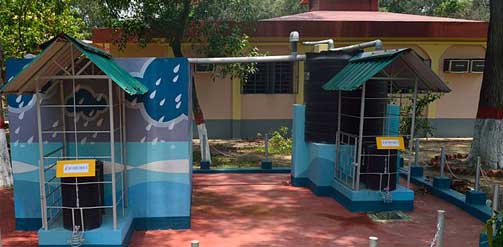In the run up to Water World Day, the UN has published the World Water Development Report (WWDR 2018). The report emphasises the need for nature-based solutions to solve the global water crisis and states that they will support the circular economy. But what exactly are nature-based solutions? How do they relate to the circular economy? And how can they work together to help achieve progress towards the Sustainable Development Goals (SDGs)?

Water challenges of the 21st century
Some of the data the report highlights are quite astonishing:
- Today, an estimated 1.8 billion people still only have access to an unimproved source of drinking water with no protection against contamination from human faeces.
- Globally, over 80 per cent of the wastewater generated by society flows back into the environment without being treated or reused.
- Growing global demand for water is predicted to exceed viable resources by 40 per cent in 2030.
- Over half of the world’s population could live in water-scarce areas by 2050.
The link between nature-based solutions and the circular economy
Nature-based solutions will be an important element to tackle these challenges. They are inspired and supported by nature and use, or mimic, natural processes to contribute to the improved management of water. There is a clear link to the circular economy, a regenerative system in which resource inputs (including water!) and waste, emission, and energy leakage are minimised by slowing and closing energy, material and water loops. The global water cycle is already a circular system, and the linear economic system of “make-use-dispose” has severely interrupted many of the natural local and regional water cycles. A regenerative and restorative circular economy using nature-based solutions can help rebalance the natural water cycle and address issues of water availability, water quality, ecosystem degradation and managing water-related risks.
Examples of circular, nature-based solutions for water include a range of approaches ranging from micro-level solutions such as rainwater harvesting, dry toilets and eco-sanitation, or alternative ways to manage wastewater and effluent from agriculture. These methods will need to be applied to end water poverty, improve access to clean drinking water and sustainable access to water, sanitation and hygiene (WASH) – a key public health issue within international development and the focus of Sustainable Development Goal (SDG) 6. Other more macro-level approaches such as green water infrastructures and landscape and wetland restoration are needed to make cities more resilient against flooding and climate change, contributing to SDG 11 on sustainable cities and communities.
Nature-based solutions for water from the Global South
The WWDR report highlights numerous case studies of nature-based solutions. Unsurprisingly, many of these solutions originate from and are in active use the Global South, and have a more community-focused approach to monitoring and managing of water resources. Examples include landscape restoration to improve water security in drought-stricken Rajasthan, which has brought back water to more than 1000 villages. In the arid South of Zimbabwe, irrigation gardens of the Sashane river use nature-based sand dam water storage that work in conjunction with low-cost, low-lift solar-powered pumps, allowing farmers to access water for supplementary irrigation and mitigate the risks related to water availability.
Nature-based solutions can also work to address water challenges in urban settings. A new concept is China’s “Sponge Cities” designed to help with flood control and water conservation through rainwater storage and reuse. The concept of the ‘sponge city’ was established in China in 2012 and currently 16 cities in China are implementing pilot projects, including a number of individual solutions such as green roofs, permeable pavements, bio-retention, storms ponds and constructed wetlands in urban areas that use natural processes involving wetland vegetation, soils, and their associated microbial assemblages to improve water quality.
New water challenges: Microplastics in rivers and plastic fibres drinking water
Despite the comprehensiveness of the WWDR 2018 report, there are some gaps. The link between plastics pollution and water has become a hot topic in recent months, but the word “plastic” is not mentioned once in the report. Latest research shows that plastic is not just floating in a remote patch in the Pacific ocean, but microplastics are accumulating in river beds and plastic fibres have been found in both tap water and in more than 90 per cent of bottled drinking water across the world. These are complex challenges that require new thinking. As the World Health Organisation (WHO) is launching a review into the health risks of micro plastics in drinking water, new circular economy solutions are urgently needed to separate the plastics cycle from the water cycle and keep our drinking water safe. Although plastics are by no means a nature-based product, nature-based solutions could provide the answer to how to solve the global plastics pollution crisis.
Water as universal development issue
Access to clean and safe water is a universal development issue, not just a problem for developing countries. Issues such as plastic fibres in bottled water or the inefficient and expensive municipal sewage systems and wastewater treatment in our cities, show that developed countries need to re-think the way water is used and wasted.
The actual percentage of fresh water that will be easily accessible to us to fuel and feed over nine billion people by 2050 is only about 0.007% of the planet’s total water resources (referred to some hydrologists as the James Bond phenomenon). We not only need to become much smarter how we use these limited available fresh water resources, but also ensure that it will be shared in a fair way.
The circular economy, including nature-based solutions, provides an ideal framework to not only rethink our current water consumption patterns, but also to understand how the current linear models of consumption and production impacts on water resources, and how we can move towards more sustainable consumption and production practices that work with the natural water cycles, rather than against them.
Photo credit-Attribution: Biswarup Ganguly. Rooftop Rainwater Harvesting System – Digha Science Centre – New Digha – East Midnapore 2015-05-03 9929